Rayonix HS (High Speed) CCD Detector Series

MX340-HS

MX225-HS

LX255-HS

LX170-HS

SX85-HS
The HS series is the latest addition to the line of CCD-detectors. It implements leading frame transfer technology that makes the new detectors as fast as pixel detectors (up to 140 frames/second) without compromising data quality and resolution. Thus, the HS detectors are ideally suited for experimental conditions where the read-out time of a detector becomes the bottleneck and not the amount of available X-ray photons, i.e. mostly on high brilliance synchrotron sites. Typical usage include high throughput single crystal crystallography including time-resolved studies, small- and wide angle scattering experiments (SAXS/WAXS), powder diffraction, X-ray computed tomography. Without the count-rate limitations of the competing pixel detectors, they are equally well suited for the upcoming X-ray electron laser beamlines (XFEL).
The detectors are available as single chip detectors (SX-30, SX-85) or as mosaic arrangements with 2x2, 3x3, 4x4 or 5x5 arrays with varying fibre optic taper sizes. In order to allow SAXS to pass through while measuring WAXS, scientists have been asking for an X-ray detector with a hole in the middle. The resulting LX series has a long, rectangular detecting surface, engineered with a notch to allow the direct beam and SAXS data to pass through.
Despite of their modular setup, the mosaic detectors come without gaps between the individual modules which is a considerable advantage over competing pixel detectors. The models differ most distinctively in the amount of built-in CCD-chips and the corresponding active area. The following table gives an overview of specifications common to the entire series and point out the few relevant differences.
HIGHLIGHTS
EXCLUSIVE SENSOR WITH HIGH SPEED FRAME-TRANSFER TECHNOLOGY
LOW NOISE, ULTRA FAST READOUT
LOW TEMPERATURE, LOW DARK CURRENT
FACTORY CALIBRATION
COMPARISON CHART
| Model | SX-30 | SX-85 | MX-170 | MX-225 | MX-300 | MX-340 | MX-425 |
| X-ray sensitive surface [mm x mm] | 30 x 30 | 85 x 85 | 170 x 170 | 225 x 225 | 300 x 300 | 340 x 340 | 425 x 425 |
| Number of CCD-chips | 1 | 1 | 4 | 9 | 16 | 16 | 25 |
| Fiber-optic taper demagnification ratio | 1 : 1 | 2.92 : 1 | 2.92 : 1 | 2.60 : 1 | 2.60 : 1 | 2.92 : 1 | 2.92 : 1 |
| Pixel in full image | 19202 | 19202 | 38402 | 57602 | 76802 | 76802 | 96002 |
| Pixel size in full image [μm] | 16 | 44 | 44 | 39 | 39 | 44 | 44 |
| Model | LX-170 | LX-255 |
| X-ray sensitive surface [mm x mm] | 85 x 170 | 85 x 255 |
| Number of CCD-chips | 2 | 3 |
| Fiber-optic taper demagnification ratio | 2.92 : 1 | 2.92 : 1 |
| Pixel in full image | 1920 x 3840 | 1920 x 5760 |
| Pixel size in full image [μm] | 44 | 44 |
COMMON SPECS
| Detective quantum efficiency (DQE) at 8-12 keV | up to 0.8 |
| Point spread function | FWHM < 100 μm FW 1% < 300 μm |
| Gain (electrons per 12 keV X-ray photon) | 70 e¯ |
| Read-out noise in standard readout mode | < 8 e¯/pixel |
| Pixels per chip | 1920 x 1920 |
| No. of on-chip read-out channels | 16 |
| Dark current at -80°C | ≤ 0.003 e¯/pixel/sec |
| Full well capacity for 12 keV photons | 400 ke¯/pixel |
| Dynamic range | 16 bits |
| Phosphor | Gd2O2S:Tb <40 μm thick |
| Weight | < 60 kg |